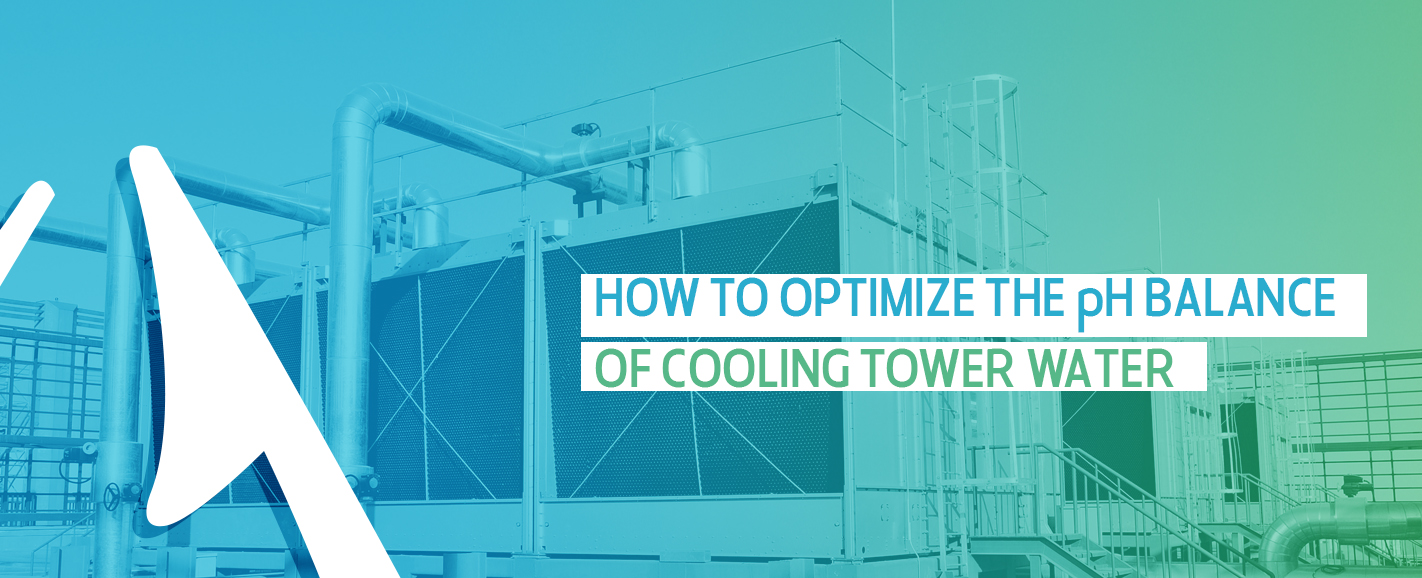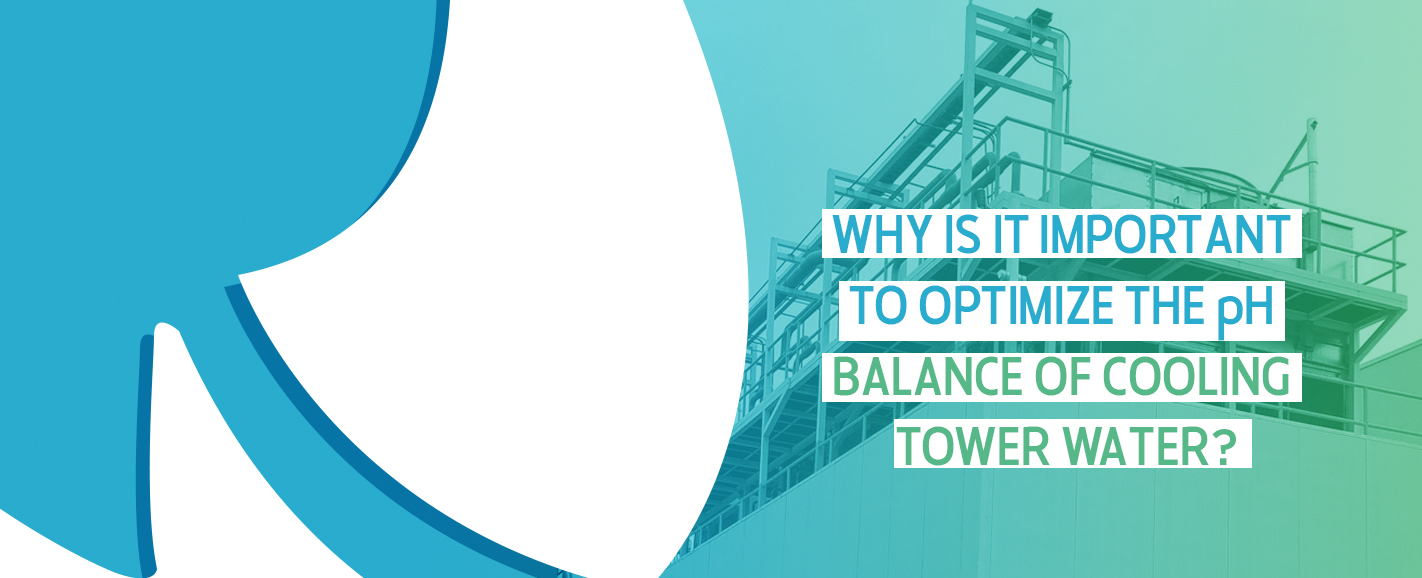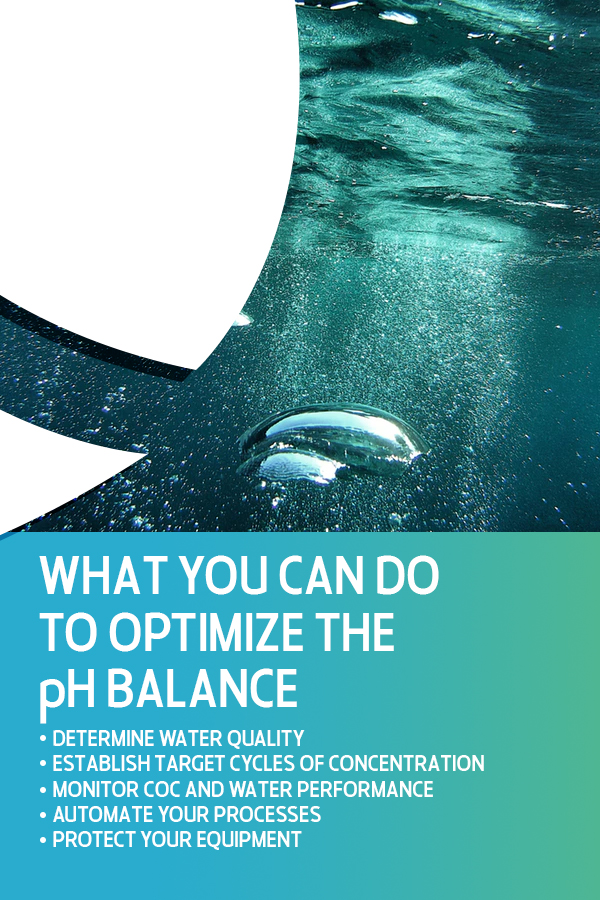
Cooling towers are an essential part of your business — they supply electricity, help maintain building temperature and may even play a pivotal role in your manufacturing processes. Because they’re so important, it’s crucial that they stay in good working order. One of the most challenging aspects of cooling tower maintenance is chemical control, otherwise known as water pH.
If your water’s pH doesn’t stay within optimal levels, you may face premature corrosion, contamination and long-term damage, both to your cooling tower and its connected systems. Learn more about the ideal cooling tower conductivity range and pH levels so you can protect your business from expensive repairs and extend the life span of your systems.
The chemical property known as pH, or “power of hydrogen,” refers to the balance of hydronium (H3O+) or hydrogen (H+) and hydroxide (OH–) in an aqueous solution — in this case, your process water. It determines how acidic or basic the water is. The more alkaline — more basic — a solution is, the more hydroxide it contains and the higher its pH. The more acidic the solution is, the more hydronium it contains and the lower its pH.
The pH scale is a logarithmic scale. For every one increase in pH, the alkalinity increases by a factor of 10. The neutral pH of pure water is 7. Measurements below 7 correspond to acidic solutions. Stronger acids have lower pH values.
When you face a pH imbalance in your cooling tower, it is due to impurities in the water. Instead of a straight flow of hydrogen and oxygen, your cooling tower will encounter minerals like calcium carbonate. This basic mineral often collects in systems and leads to damaging mineral accumulation and scale, which will ultimately lower your efficiency and increase the chances of malfunction.
The allowable pH ranges for different cooling towers vary. The material the tower is made from determines the ideal pH of the water as well as possible treatments against scale and corrosion. Galvanized steel’s optimum pH ranges from 6.5 to 9, but type 316 stainless steel has a broader pH range, from 6.5 to 9.5.
Iron, likewise, is highly soluble in water and, therefore, subject to corrosion at a pH between about 9 and 11.5. However, even when a facility maintains pH in the desired ranges, issues can still often develop in the absence of inhibitor treatments.
Other properties of the water, such as conductivity, hardness and alkalinity, also have different target values depending on the tower’s material because of potential reactions between the metal and minerals in the water.
Water treatment options are not universal for all cooling towers. For example, while using acids to neutralize alkaline water in cooling towers is an option, this may not always be the best course of action.
In some cases, fixing this issue is as easy as adding an acidic substance — such as ascorbic, hydrochloric or sulfuric acid — to the water to balance out pH levels. However, many cooling towers have parts that are easily affected by these substances and are otherwise dangerous to handle.
In one example cited by Power Magazine, when the standard method of reducing alkalinity involved adding sulfuric acid, the carbonate in the water turned into carbon dioxide. To complement the treatment, experts also treated the water with sodium dichromate, which created toxic hexavalent chromium.
Since then, acid treatments have diminished in popularity and have been replaced by chemical treatment programs. Alkaline phosphates with anodic and cathodic scale inhibitors are often effective. Polymer treatments are also increasing in popularity. We recommend that your facility always get a customized tower water treatment plan for the best results.

Maintaining balanced pH levels for your tower is critical for preventing scale and corrosion. The ideal pH values depend on the metal the cooling tower is made from since solubility at specified pH ranges tends to differ for different metals. If you have doubts about the proper pH levels for your tower water, ask your water treatment company for recommendations.
A pH between 6.5 and 7.5 is generally considered the ideal range for reducing scale formation, though some non-acid treatments for scale prevention can increase the cooling tower pH range up to 8.5. The pH also depends on the cycles of concentration (COC). COC refers to the amount of dissolved minerals and other solids present in the water. Operating at higher COC allows the tower water to have a higher pH, even up to 10.
Even when your facility maintains the proper pH levels to prevent scale, other problems may arise. For instance, chlorine does not kill microbes as effectively in water that is more alkaline than a pH of 7.5. For tower water containing microbial life, chlorine may not be the best treatment option, especially if the water has a high pH. Other options are more effective at high pH values — chlorine dioxide, for instance, works well regardless of the pH of the water.
One means of protecting against corrosion in towers made of stainless steel, copper or steel is increasing the pH to 8.5 or above. Raising the COC allows the carbonate concentration in the water to increase, boosting the alkalinity. Though higher alkalinity levels can cause scale formation, they prevent corrosion in certain types of metals and also inhibit bacterial growth.
When the pH deviates from the prescribed range, several undesirable effects may occur:
While these problems pose challenges for your facility, they can be controlled and corrected. With careful monitoring and control of the water chemistry, you can balance pH while reducing the chances of corrosion and scale.
Maintaining the ideal pH balance in tower water is a continual process that requires constant vigilance and control. Following all these steps will help ensure the proper pH balance for your facility:

Start by measuring the water’s pH, alkalinity, hardness and conductivity. These values will establish a baseline for treatment. These properties each play parts in the formation of scale or corrosion:
To establish the target cycles of concentration, your facility will need to determine the makeup water quality. The value of the makeup water quality comes from either the company treating your cooling tower water or from your municipality. There are several means of calculating COC, one of which is the following provided by the Environmental Defense Fund (EDF):
Use this formula to identify the COC your tower currently uses. You can also employ this formula to periodically monitor water use to minimize water waste. Remember, COC and water efficiency are directly linked, so keeping track of COC will help you see if your facility is losing water.
The number of cycles of concentration must carefully balance the need for efficiency and the need to prevent scale formation. More cycles will allow the accumulation of more dissolved minerals in the water, leading to scale and corrosion. Evaporation will do the same, but higher COC will also increase water efficiency. Fortunately, there are ways to improve water efficiency without increasing COC. Depending on the water makeup, you could reuse wastewater from other facility processes in the cooling tower as long as the water chemistry in the tower remains unchanged.
For better water efficiency, maximize the COC without sacrificing solids accumulation. According to the Office of Efficiency & Renewable Energy, raising the COC from three to six reduces blowdown by 50% and makeup water by 20%. Most towers use between two and four COC. Increasing the COC while keeping the water chemistry balanced can often enable your facility to become more water-efficient.
Keep an eye on the chemical balance in your water. Use real-time monitors to get the most accurate, up-to-date information that reflects changes in evaporation and water use. Couple these monitors with automating devices to get the most out of the data you collect. Regular monitoring of your facility’s COC and water quality will ensure the ideal pH balance to prevent scale formation, corrosion and bacterial growth.
Cut down on the over-application of chemicals to your cooling tower water by installing an automated chemical dispenser that regulates the water chemistry automatically. These devices dispense chemicals to treat the water whenever chemical levels deviate from preset values. These devices maximize efficiency while enabling real-time water monitoring.
Other cooling tower controller devices you can use to automate the upkeep of your water include:
Though you may have adequate water chemistry monitoring and automatic chemical controls, you still need to take measures to protect your equipment. Corrosion can occur even in well-controlled cooling tower environments. Use coupons to measure wear rates. Doing so will verify the effectiveness of your water treatment.
Secondly, don’t neglect regular inspections and repairs of your tower and all monitoring and chemical control equipment. If your monitoring equipment fails, you will lose the vital data you need to make correct changes to the water chemistry. Also, if the automated systems for controlling flow or conductivity fail, your system will operate below its maximum efficiency.
Once you’ve established the parameters for balancing your cooling tower’s pH, work with your water treatment company. The vendor will have the supplies and methods necessary to get your cooling tower water within the ideal chemical ranges. Communicate all your expectations thoroughly, and don’t be afraid to ask questions.
A reputable water treatment vendor will design a customized plan to help you balance pH to prevent corrosion and scale. Since every situation is different, you will need to be ready to answer any questions about your facility and cooling tower. Accurate answers will ensure you get the best water treatment and the ideal water quality to prevent damage to your equipment.
At Chardon Labs, we have years of experience offering these services to thriving businesses like your own. Our technicians pride themselves on delivering world-class service at a guaranteed fixed price. Scale-free systems are more efficient, and they’re exactly what we deliver to keep your operations running smoothly.
Protecting the water in the tower from contamination will also protect the rest of the system. Because cooling towers have external exposure, they are the most significant source of water contamination for water systems. Treating the water in your cooling tower for pH can prevent problems like rust and corrosion in the entire system.
Water treatment is just one of the many services we offer at Chardon Labs. We provide the means to keep your cooling tower water chemically balanced. We do much more than sell chemicals — our job is to create clean systems for our customers. We are happy to create a custom treatment plan tailored to your water and cooling tower design. Our ISO 9000 certification proves we bring skill and understanding to every jobsite, from initial consultations to ongoing preventive maintenance.
If you want your facility to have a cleaner cooling tower, contact the water treatment experts at Chardon Labs. We will discuss your facility’s needs and use the information you provide to develop the best solutions for maintaining a proper pH balance in your cooling tower water. Using water with a balanced pH will prevent problems and extend the life of your cooling tower and connected systems. We look forward to assisting you.